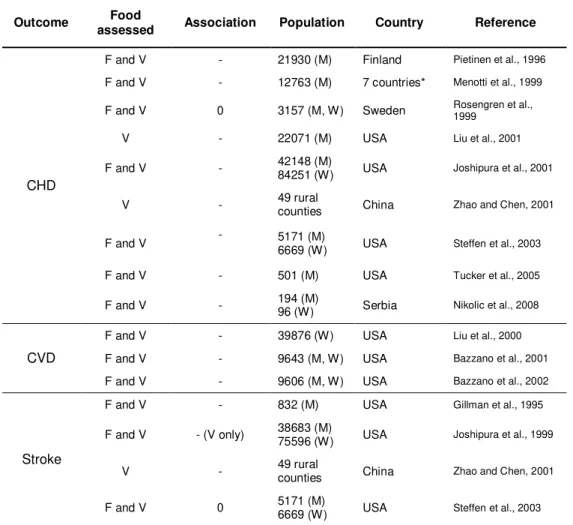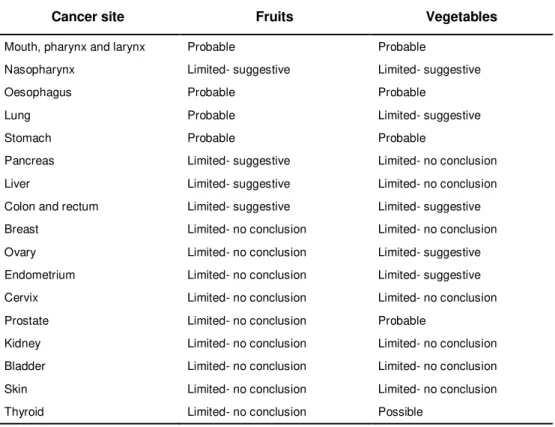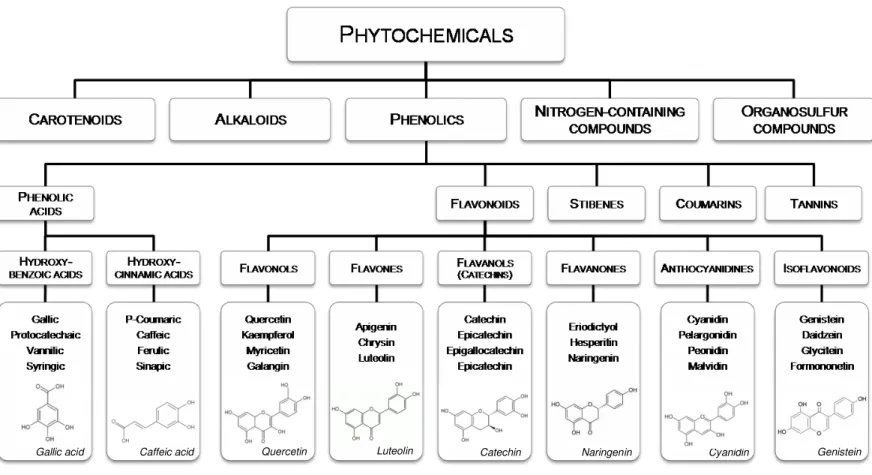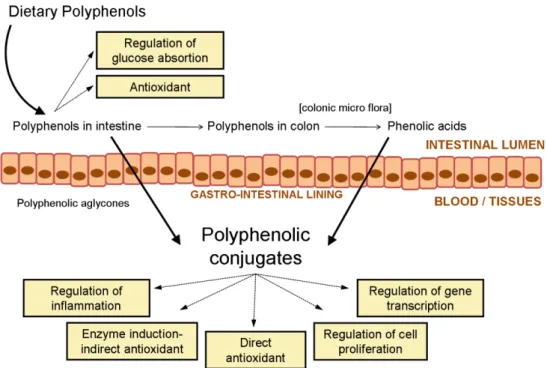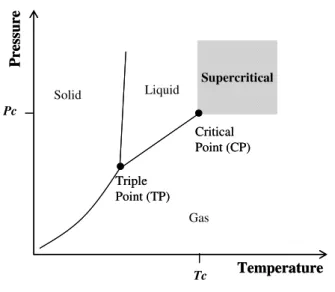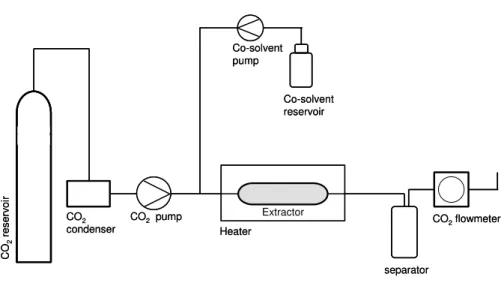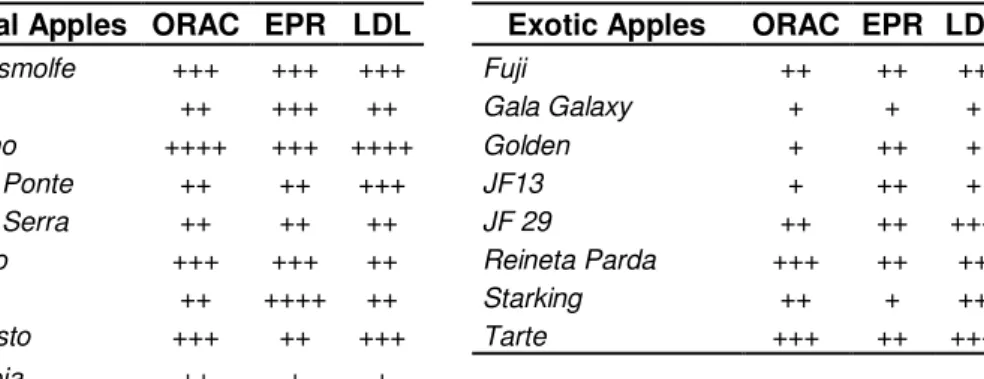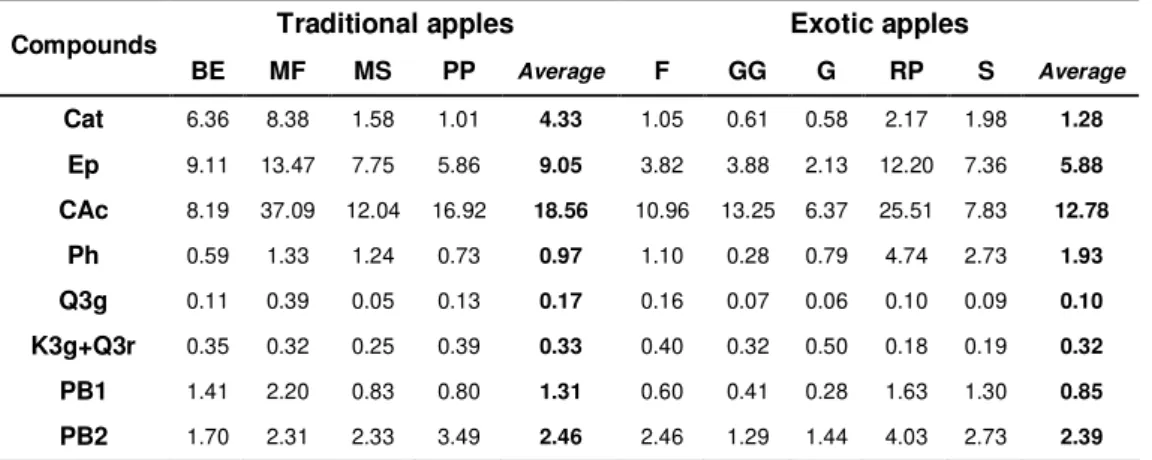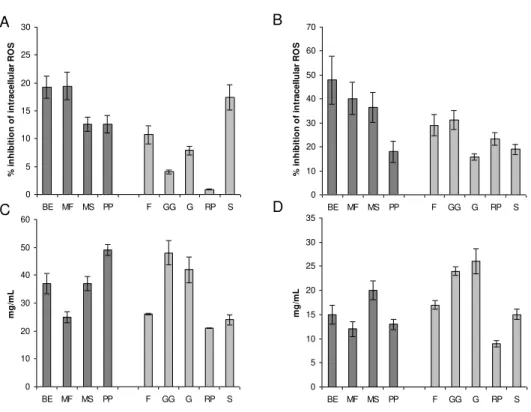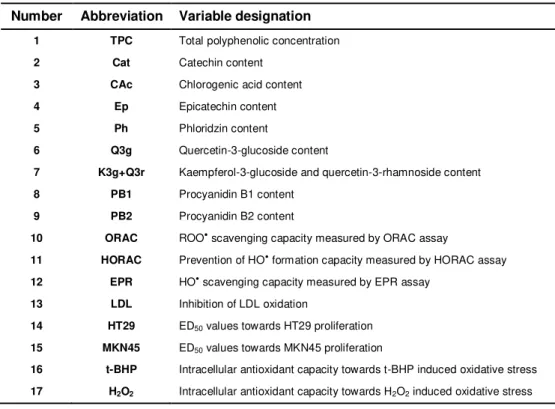Valorization of Traditional Portuguese
Apples and Cherries
Biochemical characterization and
development of functional ingredients
Ana Teresa de Carvalho Negrão Serra
Dissertation presented to obtain a Ph.D degree in Engineering and Technology Sciences, Biotechnology at the Instituto de Tecnologia Química e Biológica, Universidade Nova de Lisboa
Portuguese Apples and Cherries
Biochemical characterization and
development of functional ingredients
Ana Teresa de Carvalho Negrão Serra
Dissertation presented to obtain a Ph.D degree in Engineering and
Technology Sciences, Biotechnology at the Instituto de Tecnologia
Química e Biológica, Universidade Nova de Lisboa
Supervisor: Catarina Duarte Co-supervisor: Paula Marques Alves
Oeiras, March 2010
Biochemical characterization and development of functional ingredients
by Ana Teresa Serra
First edition: March 2010
Front cover: Bravo de Esmolfe apples, Saco cherries, high pressure extraction cell and manometer, XAD16 resins and apple and cherry lyophilized extracts
Back cover: Apple and cherry liquid and lyophilized extracts
by Ana Teresa Serra
ITQB-UNL/IBET Nutraceuticals and Controlled Delivery Laboratory Instituto de Tecnologia Química e Biológica-Universidade Nova de Lisboa/ Instituto de Biologia Experimental e Tecnológica
Av. da República EAN, 2780-157 Oeiras, Portugal Fax: +351 21 442 11 61; Phone: +351 21 446 91 00 http://www.itqb.unl.pt
http://www.ibet.pt
Copyright 2010 by Ana Teresa Serra All rights reserved
Dr. Catarina Maria Martins Duarte, Auxiliary Investigator and Head of the Nutraceuticals and Controlled Delivery Laboratory at IBET/ITQB-UNL, Oeiras, Portugal.
Co-supervisor:
Dr. Paula Maria Marques Leal Sanches Alves, Principal Investigator and Head of the Animal Cell Technology Unit at ITQB-UNL and Executive Director of IBET, Oeiras, Portugal.
Jury:
Dr. Maria Luísa Beirão da Costa, Cathedratic Professor at Instituto Superior de Agronomia, Universidade Técnica de Lisboa, Portugal;
Dr. Manuel Luís Magalhães Nunes da Ponte, Cathedratic Professor at Faculdade de Ciências e Tecnologia, Universidade Nova de Lisboa, Portugal;
Dr. Agostinho Mesquita Antunes de Carvalho, Cathedratic Professor at Instituto Superior Ciências da Saúde Egas Moniz, Portugal;
Dr. Maria do Rosário Beja Figueiredo Gonzaga Bronze, Auxiliary Professor at Faculdade de Farmácia, Universidade de Lisboa, Portugal;
Dr. Hermínio José Cipriano de Sousa, Auxiliary Professor at Faculdade de Ciências e Tecnologia, Universidade de Coimbra, Portugal.
À memória dos meus avós Clara e Camilo
Aos meus pais
I would like to express my gratitude to all the people who directly or indirectly supported and contributed to this work and without whom it would not have been possible.
To my supervisor Dr. Catarina Duarte for trusting and giving me the support to follow my ideas. I thank her for the guidance, support, patience, pragmatism, optimism, constant encouragement and for always being there. Thank you for this great journey that allowed me to grow both professionally and personally.
To my co-supervisor Dr. Paula Alves for guidance and support whenever I needed and for her valuable input in animal cell technology field.
To Professor Agostinho de Carvalho for all the support, valuable suggestions, challenging discussions and for his availability throughout these years.
To Dr. Hermínio de Sousa and laboratory of Polymer Processing and Supercritical Technology team for all the help and knowledge provided about high pressure extraction, and also for having received me in their lab that was toughly valuable to perform some of my studies. To Dr. Mara Braga for the critical discussions. A special thanks to Inês Seabra for her valuable help in my high pressure experiments, advices and fruitful discussions.
To Dr. Rosário Bronze and Analytical Group of IBET, namely Rodrigo Feliciano, Helena Calado and Giorgio Dimastrogiovanni, for their collaboration on HPLC analysis. A special thanks to Dr. Rosário Bronze for her availability and valuable discussions.
To Dr. Rui Duarte memory, for EPR spectra presented in this thesis. For his
commitment, tremendous support and pleasant “EPR days” that I miss.
“Polyphenols conference”. For her advices and friendship throughout these years, inside and outside ITQB.
To all the former and current colleagues of the Nutraceuticals and Controlled Delivery Lab for creating a great work environment through this years. Specially, to Ana Matias for the discussions, her companionship in the bench, for the enjoyable trips to conferences and for her friendship. It’s a pleasure
work with you! To Ana Nunes, my neighbour colleague, for her ideas and fruitful discussions. To Rita Duarte for her encouragement and Raquel Sousa for her enthusiasm and for all the personalized gifts. To Rodrigo Silva for his promptness to help, friendship and apple desserts. To Raquel Frade, Pedro Poejo, Duarte Rego, Patricia Almeida, Susana Martins and Mónica Faustino for their good mood, availability and occasional technical support.
To entities that founded the research: Fundação para a Ciência e Tecnologia (contract SRFH/BD/19238/2004), Instituto Nacional de Investigação Agrária das Pescas (Agro project 930/2006.09.0040012) and to Cooperativa Agrícola de Mangualde. A special thanks to Engº. António Campos and Engº. Matos Soares for their availability and enthusiasm in this work, and also for providing the apples and the cherries samples.
Aos meus amigos, pelo encorajamento, pela amizade e simplesmente por estarem sempre presentes.
Ao Pedro, pelo apoio, compreensão, carinho e o sempre presente bom humor que me ajudaram ao longo deste trabalho.
The consumption of fruits and vegetables is widely recognized to be beneficial to human health and this is mainly attributed to their high content in functional constituents, such as vitamins, carotenoids and polyphenols.
In Portugal, the annual production of apples and cherries is about 300,000 and 17,000 ton, respectively. Between all varieties produced, there are some traditional fruits, which are only cultivated in specific regions of the country. In general, these traditional varieties are very appreciated by consumers due to their unique sensorial properties. However, they are less produced and thus more expensive than exotic cultivars. Within this context, this thesis focused on the valorization of these traditional Portuguese fruits in order to increase their productivity and competition in the market.
In a first approach, traditional and exotic apples and cherries were evaluated for their bioactivity. Different analytical chemical and biochemical methodologies were developed and applied to characterize fruits in terms of phenolic content, antioxidant activity and antiproliferative effect against human colon and gastric cancer cells.
In the case of apples, 26 varieties were screened for their polyphenolic content and antioxidant potential. From the results obtained four traditional varieties (Bravo de Esmolfe, Malápio Fino, Malápio da Serra and Pêro Pipo) and five exotic fruits (Fuji, Gala Galaxy, Golden, Reineta Parda and Starking) were selected and fully characterized. The traditional varieties Bravo de Esmolfe and Malápio Fino showed to be rich sources of functional ingredients with powerful antioxidant activity and relevant antiproliferative effect. The exotic Reineta Parda was the best apple in inhibiting human gastric and colon cancer cells proliferation.
B2), phloridzin and epicatechin play an important role in inhibiting human cancer cell proliferation.
As the presence of these compounds could be regulated by environmental and climatic factors, results obtained from two consecutive crop years were also evaluated. Biological activity differences were observed however less significant than those occurred between different varieties.
In cherries, two traditional cultivars (Saco and Morangão) were studied and compared with seven exotic varieties (Summit, Maring, Van, Early Van Compact, Lapin, Ulster and Garnet). Saco cherry together with Ulster and
Lapin showed the highest content in phenolic compounds, the best antioxidant activity and the most effective response in inhibiting the growth of human colon and gastric cancer cells. When correlating bioactive response and phenolic composition, anthocyanins were identified as the major contributors of biological activities. Additionally, the presence of hydroxycinnamic acids, flavan-3-ols and flavonols demonstrated to be determinant for the protection against oxidative stress.
Within the aim of this thesis clean separation processes were applied to isolate biofunctional ingredients from rejected traditional fruits (fruits that do not fit all the requisitions to be sold as fresh edible products). Saco cherry culls and Malápio Fino apples were used as raw material due to their recognized rich content in bioactive compounds.
In order to develop biofunctional ingredients that can potentially show anticancer effect, natural extracts containing perillyl alcohol, were isolated
from Saco cherries using high pressure extraction. The methodology
employed comprised a first step with supercritical CO2 followed by a second
step where different mixtures of CO2 and ethanol were tested. The effect of a
colon cancer cells. The product derived from CO2:ethanol (90:10 v/v)
extraction exhibited the highest antiproliferative activity, being 150 times more effective than fresh fruit. In addition, cherry extract showed to be a promising natural agent to be included in cancer chemotherapy as it induced cell cycle arrest in a different check point than a common drug. In an effort to further increase the antiproliferative potential of cherry extract, different processing strategies were explored. Indeed, altering solvent purity the antiproliferative effect was significantly improved by 16 fold. Furthermore, by adding a conventional extraction step (using methanol or ethanol:water mixture) prior to multi-step high process it was possible to obtain cherry extracts with even higher antiproliferative activity (up to 2 fold).
Finally, the recovery of powerful antioxidant concentrates from Malápio Fino
apple and Saco cherry was also explored. Using a macroporous resin it was
Ao consumo de frutas e vegetais é reconhecido um efeito benéfico para a saúde que desde há muito se relaciona com a presença de ingredientes funcionais, nomeadamente vitaminas, carotenóides e polifenóis.
Em Portugal são produzidas anualmente cerca de 300,000 toneladas de maçãs e 17,000 toneladas de cerejas onde se incluem algumas variedades tradicionais cultivadas apenas em determinadas regiões do país. De um modo geral, estes frutos são bastante apreciados devido às suas características organolépticas únicas, mas, sendo produzidos em menor escala tornam-se mais dispendiosos do que as variedades exóticas.
Deste modo, o principal objectivo do trabalho desenvolvido nesta tese consistiu na tentativa de valorização das variedades tradicionais de maçã e de cereja com vista a promover a sua produção e aumentar a sua competitividade no mercado.
Numa primeira fase, foram avaliadas as propriedades bioactivas das várias variedades tradicionais e exóticas de maçãs e cerejas produzidas em Portugal. Diferentes métodos químicos e bioquímicos foram desenvolvidos e utilizados de forma a caracterizar os frutos relativamente ao teor em compostos fenólicos, capacidade antioxidante e efeito antiproliferativo em células humanas do cancro do cólon (HT29) e do estômago (MKN45).
Em relação às maçãs, o estudo incidiu inicialmente em 26 variedades, das quais se seleccionaram nove, sendo esta escolha tida por base a quantidade de polifenóis totais e o potencial antioxidante que apresentaram. As nove maçãs incluíram quatro variedades tradicionais (Bravo de Esmolfe, Malápio Fino, Malápio da Serra e Pêro Pipo) e cinco variedades exóticas (Fuji, Gala Galaxy, Golden, Reineta Parda e Starking) e foram objecto de uma
caracterização mais exaustiva. As variedades tradicionais Bravo de Esmolfe e
maçã Reineta Parda foi a variedade que apresentou um maior efeito na inibição do crescimento de células humanas do cancro do cólon e do estômago.
Foi possível correlacionar a bioactividade determinada para as diferentes variedades de maçã com a composição em polifenóis e verificou-se que a catequina, a epicatequina e a procianidina B1 foram os principais compostos responsáveis pela actividade antioxidante. A epicatequina e a procianianidina B1, juntamente com a procianidina B2 e floridzina, mostraram, também, contribuir para o efeito antiproliferativo das maçãs.
Neste trabalho avaliou-se ainda o efeito do ano de colheita uma vez que a concentração destes compostos nos frutos pode variar com as condições ambientais e climáticas. Apesar das diferenças encontradas entre os resultados obtidos em dois anos consecutivos, estas foram menos significativas do que as verificadas entre as diferentes variedades de maçãs.
No caso das cerejas, foram estudadas duas variedades tradicionais (Saco e
Morangão) e sete variedades exóticas (Summit, Maring, Van, Early Van Compact, Lapin, Ulster and Garnet). A cereja Saco, juntamente com as
variedades Ulster and Lapin, demonstrou elevada concentração em
compostos fenólicos, elevada actividade antioxidante e maior efeito na inibição do crescimento de células cancerígenas humanas. As antocianinas foram apontadas como sendo os principais compostos responsáveis pelas bioactividades apresentadas. Contudo, a presença de outros compostos, como os ácidos hidroxicinâmicos, os flavan-3-ois e flavonoides demonstrou ser, também, essencial na protecção ao stress oxidativo.
Com o intuito de obter produtos com propriedades anticancerígenas, extractos naturais contendo álcool perilílico foram extraídos da cereja Saco
utilizando uma extracção fraccionada a alta pressão. A metodologia utilizada
consistiu num primeiro passo de extracção com CO2 supercritico seguido de
um segundo passo de extracção onde foram testadas diferentes misturas de CO2 e etanol. O efeito do fraccionamento e da concentração em etanol no
solvente de extracção foram estudados tendo por base o rendimento da extracção, e a concentração em polifenóis e a actividade antioxidante dos extractos obtidos bem como a sua actividade antiproliferativa em células humanas do cancro do cólon.
A fracção obtida a partir da extracção com CO2 e etanol na proporção 90:10
(v/v) foi a que apresentou maior efeito antiproliferativo, demonstrando ser 150 vezes mais eficiente do que o fruto fresco. Quando comparado com uma droga anticancerígena, o extracto de cereja induziu a paragem do ciclo celular numa fase distinta indicando, desta forma, ser um agente natural promissor em tratamentos de quimioterapia.
Diferentes estratégias de extracção foram ainda estudadas de forma a obter extractos de cereja mais concentrados em compostos com actividade anticancerígena. Deste modo, quando se alterou o grau de pureza dos solventes de extracção foi obtido um extracto com efeito antiproliferativo 16 vezes maior. Além disso, a realização de um passo de extracção prévio à matéria prima, usando metanol ou etanol e água (50:50 v/v), contribuiu também para o aumento da actividade antiproliferativa do produto final.
celulares humanas (Caco2 e HepG2).
Por sua vez, estudos de transporte realizados em células Caco2 revelaram que os concentrados de maçã e cereja são biodisponíveis, isto é, são capazes de passar a barreira intestinal de forma a exercerem, posteriormente, o seu efeito benéfico nos vários orgãos e tecidos.
INTERNATIONAL PEER-REVIEWED JOURNAL
Serra, A.T., Matias, A.A., Frade, R.F.M., Duarte, R.O., Feliciano, R.P., Bronze, M.R., Figueira, M.E., de Carvalho, A., Duarte, C.M.M. (2010). Characterization of traditional and exotic apple varieties from Portugal. Part 2- Antioxidant and antiproliferative activities. J Funct Foods, 2, 46-53.
Feliciano, R.P., Antunes, C., Ramos, A., Serra, A.T., Figueira, M.E., Duarte,C.M.M., Carvalho, A., Bronze, M.R. (2010). Characterization of traditional and exotic apple varieties from Portugal. Part 1- Nutritional, phytochemical and sensory analysis, J Funct Foods, 2, 35-45.
Serra, A.T., Duarte, R.O., Bronze, M.R., Duarte, C.M.M. (2010). Identification of bioactive response in traditional cherries from Portugal, Food Chem, accepted. Serra, A.T., Seabra, I.J., Braga, M.E.M, Bronze, M.R., Sousa, H.C., Duarte, C.M.M. (2010). Processing cherries (Prunus avium) using supercritical fluid technology. Part 1- Recovery of extract fractions rich in bioactive compounds. J Supercr Fluids,
accepted.
Serra, A.T., Matias, A.A., Almeida, A.P., Bronze, M.R., Alves, P.M., Sousa, H.V., Duarte, C.M.M. (2010). Processing cherries (Prunus avium) using supercritical fluid technology. Part 2- Evaluation of SCF extracts as promising natural chemotherapeutical agents, J Supercr Fluids, accepted.
INTERNATIONAL CONFERENCES PROCEEDINGS
Serra, A.T., Matias, A.A., Feliciano,R., Bronze,M.R., Duarte,R.O., Carvalho,A., Alves,P.M., Duarte,C.M.M. (2008). Looking for functionality in apple cultivars- a study focused on radical scavenging and anticancer activity. Proceedings of the XXIV International Conference on Polyphenols, Vol II, 805-806.
BOOK CHAPTERS
Carvalho, A., Serra, A.T., Espada, J.M., Paulo, M.R., Duarte, C.M.M. (2008). “Polifenóis e actividade antioxidante em maçãs de variedades regionais e de cultivares exóticas” in Variedades regionais e agricultura biológica. Desafios para peras e maçãs portuguesas (Orlando Simões, Arminda Lopes e Jorge Ferreira, ed.), Coimbra, ESAC/DRAPC, 120-133.
AA antioxidant activity
AAPH 2’,2’-Azobis (2-amidinopropane) dihydrochloride ABTS 2’,2’-azino-bis (3-ethylbenzthiazoline-6-sulphonic acid) ATCC American Type Cell Collection
BE Bravo de Esmolfe apple
BSA bovine serum albumin
C3g cyanidin-3-glucoside
C3g cyanidin-3-glucoside
C3r cyanidin-3-rutinoside
CAA cellular antioxidant activity
Cac chlorogenic acid
CAc chlorogenic acid
Caco2 Caco2 human colon carcinoma cell line CAE caffeic acid equivalents
Cat catechin
CHD coronary heart diseases
CSE conventional solvent extraction
CVD cardiovascular diseases
DAD diode array detector
DCFH-DA 2’,7’-dichlorofluorescin diacetate DMPO 5,5-dimethyl-1-pyrroline-N-oxide
DMSO dimethyl sulphoxide
DSMZ Deutsche Sammlung von Mikroorganismen und Zellkulturen
dw dry weight
ECACC European Collection of Cell Culture
ED electrochemical detector
ED50 median effective dose
EDTA ethylenediamine tetraacetic acid
Ep epicatechin
EPR electron paramagnetic resonance ESE enhanced solvent extraction
EtOH ethanol
FBS fetal bovine serum
FL disodium fluorescein
fw Fresh weight
G Golden apple GAE gallic acid equivalents GG Gala Galaxy apple Gn Garnet cherry
HBSS Hank’s buffered salt solution
HepG2 HepG2 human hepatocellular carcinoma cell line HL-60 HL-60 human leukemic cell line
HORAC hydroxyl radical adverting capacity HPLC high performance liquid chromatography HT29 HT29 human colon cancer cell line IFEC Instituto de Formação e Educação Coop
IPATIMUP Instituto de Patologia e Imunologia Molecular da Universidade do Porto
K3g kaempferol-3-glucoside
LC-DAD-MS/MS liquid chromatography with diode array detection mass spectrometry LDL low density lipoprotein
Lp Lapin cherry Ma Maring cherry
MEM minimum essential medium
MetOH methanol
MF Malápio Fino apple
MHPE Multi-step high pressure extraction MKN45 MKN45 human stomach cancer cell line Mo Morangão cherry
MS Malápio da Serra apple
MTT methylthiazolyldiphenyl - tetrazolium bromide
NcAc Neochlorogenic acid
NCI National Cancer Institute
NEAA Non essential aminoacids
ORAC oxygen radical absorbance capacity
PA picolinic acid
Papp apparent permeability coefficient
PCA principal component analysis pCqAc p-Coumaroylquinic acid PDO protected designation of origin PGI protected geographical indication
Ph phloridzin
Pl3r pelargonidin -3-rutinoside
Pn3g peonidin-3-glucoside
Pn3r peonidin-3-rutinoside
POH perillyl alcohol
PP Pêro Pipo apple
PRC polyphenol-rich concentrate
Q3g quercetin-3-glucoside
Q3r quercetin-3-rhamnoside
RNS reactive nitrogen species
ROO peroxyl radicals
ROS reactive oxygen species
RP Reineta Parda apple
Rut rutin
S Starking apple
Sc Saco cherry
SE solvent extract
SFE supercritical fluid extraction Sm Summit cherry
SPE solid phase extraction
TAC total anthocyanin content t-BHP t-butyl hydroperoxide
TEAC Trolox equivalents antioxidant capacity
TED total area of chromatogram obtained with electrochemical detection TEER transepithelial electrical resistance
TLC thin layer chromatography
TPC total polyphenolic content
Figure 1.1 Page 7 Classification of dietary phytochemicals
Figure 1.2 Page 9 Schematic representation of the main processes by which phenolics mediate health benefit
Figure 1.3 Page 10 Total phenolic content of selected fruits
Figure 1.4 Page 13 Definition of supercritical state for a pure component
Figure 1.5 Page 16 Schematic diagram of a process-scale supercritical fluid extraction
system
Figure 1.6 Page 20 Chemical structure of Amberlite XAD 16
Figure 1.7 Page 23 Thesis rational
Figure 2.1 Page 54 Total phenolic content of 26 apple varieties from Portugal
Figure 2.2 Page 57 Antioxidant activity of traditional and exotic apple varieties (ORAC,
EPR and LDL results)
Figure 2.3 Page 59 Antioxidant potential of 17 apple cultivars
Figure 2.4 Page 62 Bioactivity of nine apple varieties (cellular antioxidant and antiproliferative activities)
Figure 2.5 Page 64 Distribution of four traditional apples and five exotic varieties along principal components 1 and 2, using 17 variables
Figure 2.6 Page 65 HORAC values of nine apple varieties
Figure 2.7 Page 65 Kinetics of LDL oxidation in the presence of apple extracts
Figure 2.8 Page 69 Comparison between total phenolic content of traditional and exotic apples harvested in 2006 and 2007
Figure 2.9 Page 70 Comparison between phenolic content of traditional and exotic apple
varieties harvested in 2006 and 2007
Figure 2.10 Page 72 Variation of antioxidant capacity of apples between 2006 and 2007
crop years
Figure 2.11 Page 74 Comparison between bioactivity of traditional and exotic apples
harvested in 2006 and 2007
Figure 2.12 Page 95 Distribution of nine Portuguese cherry varieties along principal
component 1 and 2, using 24 variables
Figure 2.13 Page 97 Chromatographic profile of Saco variety extract using ED
Figure 2.14 Page 100 Effects of cherry extracts on H202 and t-BHP induced ROS in Caco2
cells
Figure 3.1 Page 116 Schematic diagram of the employed high pressure extraction
Figure 3.3 Page 126 Effect of solvent EtOH concentration on polyphenols and anthocyanins extracted from dried Saco cherry
Figure 3.4 Page 127 Cherry extracts obtained by multi-step high pressure extraction
Figure 3.5. Page 128 Chromatographic profile of cherry extracts derived from multi-step
high pressure process, using HPLC-DAD at 280nm
Figure 3.6 Page 129 Comparison of cherry extracts derived from multi- and single-step
high pressure process: total polyphenols extracted, total anthocyanins extracted and antioxidant activity.
Figure 3.7 Page 130 Chromatographic profile of cherry extracts derived from multi- and single-step high pressure process using HPLC-DAD at 280nm
Figure 3.8 Page 131 Antiproliferative activity of cherry extracts in human colon cancer cells
Figure 3.9 Page 132 Comparison of antiproliferative activity in human colon cancer cells of cherry extracts derived from multi- and single-step process
Figure 3.10 Page 133 Cell cycle analysis by flow cytometry of HT29 cells incubated with
cherry extracts or doxorubicin
Figure 3.11 Page 135 Antiproliferative activity of cherry extracts
Figure 3.12 Page 136 HPLC chromatogram at 280 nm of cherry extracts
Figure 3.13 Page 137 Experimental outline used in the integration of conventional solvent and multi-step high pressure extraction of Saco cherry
Figure 3.14 Page 138 Effective dose values of cherry extracts against HT29 proliferation,
after 24h of incubation
Figure 3.15 Page 160 Picture of apple and cherry polyphenols-rich concentrates
Figure 3.16 Page 161 Total phenolic content of polyphenols-rich concentrates and solvent extracts
Figure 3.17 Page 162 Antioxidant activity of apple and cherry extracts (ORAC and HORAC values)
Figure 3.18 Page 164 Cellular antioxidant activity of apple and cherry polyphenols-rich concentrates
Figure 3.19 Page 165 Bioavailability in vitro test: Caco2 cell model
Table 1.1 Page 4 Association between fruit and vegetables intake and cardiovascular disease, choronary heart disease and stroke: selected epidemiological studies
Table 1.2 Page 5 Summary of the main conclusions of the WCRF-AICR report on the
possible effect of high fruit and vegetable consumption on cancer risk
Table 1.3 Page 8 Summary of main current findings about phenolics and their
potential health benefits
Table 1.4 Page 11 Polyphenolic compounds identified in apples and sweet cherries
Table 1.5 Page 18 SFE of oils and high added value compounds
Table 1.6 Page 22 Phytochemicals recovery from plant sources using adsorption
process
Table 2.1 Page
44-45 Origin and harvest year of traditional Portuguese apples selected for this study
Table 2.2 Page 46 Origin and harvest year of exotic apples selected for this study
Table 2.3 Page 55 Total phenolic content of 18 traditional and 8 exotic apple varieties
Table 2.4 Page 56 Antioxidant activity of 17 apple varieties
Table 2.5 Page 58 Classification of apples according to their antioxidant activity
Table 2.6 Page 60 Phytochemical composition of traditional and exotic apples
Table 2.7 Page 63 Numbers and abbreviations of 17 variables considered for PCA of apples
Table 2.8 Page 66 Correlation values between phenolic content of apples and both
antioxidant and antiproliferative tests
Table 2.9 Page 71 Antioxidant capacity in Portuguese apples (traditional and exotic
varieties) of 2006 and 2007 crop years
Table 2.10 Page 92 Phytochemical composition of traditional and exotic cherries
Table 2.11 Page 93 Antioxidant and antiproliferative activities of cherry varieties
Table 2.12 Page 94 Numbers and abbreviations of 24 variables considered for PCA of
cherries
Table 2.13 Page 96 Correlation coefficients between phenolic content of cherries and
both antioxidant and antiproliferative assays
Table 3.3 Page 135 Characterization of cherry extracts obtained using MHPE or CSE+MHPE.
Table 3.4 Page 161 Yield and phenolic content of apple extracts
Table 3.5 Page 161 Yield and phenolic content of cherry extracts
Table 3.6 Page 163 ORAC values of polyphenols-rich concentrates, vitamin C and commercial extracts
Table 3.7 Page 164 Cellular antioxidant quality of PRCs and fruit in the cellular antioxidant assay performed in HepG2 cells with AAPH
C
HAPTER1:
I
NTRODUCTION…………...………...……... 1C
HAPTER2:
I
DENTIFICATION OFB
IOACTIVER
ESPONSE INT
RADITIONALP
ORTUGUESEF
RUITS………...………..………...……..37P
ARTI-
APPLES………...………..….………...….…39PART II-CHERRIES………...………..………...………..….. 81
C
HAPTER3:
D
EVELOPMENT OFF
UNCTIONALI
NGREDIENTS……….…...107P
ARTI-
ISOLATION OF AN ANTICANCER EXTRACT FROM CHERRY (SACOVARIETY), USING HIGH PRESSURE EXTRACTION……….109
PART II-ISOLATION OF ANTIOXIDANT CONCENTRATES FROM MALÁPIO FINO
APPLE AND SACO CHERRY………...……...147
C
HAPTER4:
F
INALD
ISCUSSION………..………..……..….…….173C
HAPTER
1
T
ABLE OFC
ONTENTS1.DIET AND HEALTH …………...………....3
1.1.EPIDEMIOLOGICAL EVIDENCE ……….……….. 3
1.2.PHYTOCHEMICALS AND THEIR BIOACTIVITY …….………..……...5
1.3.APPLES AND CHERRIES …….…... 9
2.NUTRACEUTICALS AND FUNCTIONAL FOODS …….……..………...……...12
2.1.HIGH PRESSURE EXTRACTION ………....………...
.
132.2.ADSORPTION TECHNOLOGY ……….………...…... 18
3.SCOPE AND STRUCTURE OF THE THESIS …….…...….………...23
1.
D
IET ANDH
EALTHIn recent years, the relationship between the consumption of specific foods and the risk of developing chronic diseases has been extensively discussed in the literature and there is appreciable evidence demonstrating a protective role of diets rich in fruits and vegetables. Eating at least five servings per day has been recommended to reduce the risk of cancer and cardiovascular diseases.
1.1. EPIDEMIOLOGIC EVIDENCE
Table 1.1. Association between fruit and vegetables intake and cardiovascular disease,
choronary heart disease and stroke: selected epidemiological studies (adapted from Kris-Etherton et al., 2002)
Outcome Food
assessed Association Population Country Reference
CHD
F and V - 21930 (M) Finland Pietinen et al., 1996 F and V - 12763 (M) 7 countries* Menotti et al., 1999 F and V 0 3157 (M, W) Sweden Rosengren et al., 1999
V - 22071 (M) USA Liu et al., 2001
F and V - 42148 (M) 84251 (W) USA Joshipura et al., 2001
V - 49 rural counties China Zhao and Chen, 2001
F and V - 5171 (M) 6669 (W) USA Steffen et al., 2003
F and V - 501 (M) USA Tucker et al., 2005
F and V - 194 (M) 96 (W) Serbia Nikolic et al., 2008
CVD
F and V - 39876 (W) USA Liu et al., 2000 F and V - 9643 (M, W) USA Bazzano et al., 2001 F and V - 9606 (M, W) USA Bazzano et al., 2002
Stroke
F and V - 832 (M) USA Gillman et al., 1995 F and V - (V only) 38683 (M) 75596 (W) USA Joshipura et al., 1999
V - 49 rural counties China Zhao and Chen, 2001
F and V 0 5171 (M) 6669 (W) USA Steffen et al., 2003
-, inverse association; 0, no association; CHD, coronary heart disease; CVD, cardiovascular disease; F, fruits; V, vegetables; M, men; W, women
* USA, Finland, Netherlands, Italy, former Yugoslavia, Greece and Japan
For cancer, more than 200 epidemiological studies have been performed but the findings are not conclusive. Despite that, the 2007 report Food, Nutrition, Physical Activity and the Prevention of Cancer: A Global perspective by the WCRF-AICR* indicate a probable protective role of fruit, vegetables and their
constituents against some types of cancer (Table 1.2).
Table 1.2. Summary of the WCRF-AICR report on the possible effect of high fruit and vegetable
consumption on cancer risk
Cancer site Fruits Vegetables
Mouth, pharynx and larynx Probable Probable
Nasopharynx Limited- suggestive Limited- suggestive
Oesophagus Probable Probable
Lung Probable Limited- suggestive
Stomach Probable Probable
Pancreas Limited- suggestive Limited- no conclusion Liver Limited- suggestive Limited- no conclusion Colon and rectum Limited- suggestive Limited- suggestive Breast Limited- no conclusion Limited- no conclusion Ovary Limited- no conclusion Limited- suggestive Endometrium Limited- no conclusion Limited- suggestive Cervix Limited- no conclusion Limited- no conclusion Prostate Limited- no conclusion Probable
Kidney Limited- no conclusion Limited- no conclusion Bladder Limited- no conclusion Limited- no conclusion Skin Limited- no conclusion Limited- no conclusion Thyroid Limited- no conclusion Possible
The health promoting effect of fruit and vegetables is related with their bioactive constituents, in particular phenolic compounds. These substances act through several mechanisms, such as reducing oxidative stress, improving lipoprotein profile, lowering blood pressure and improving homeostasis regulation thus contributing to a healthy lifestyle (Scalbert et al., 2005).
1.2. PHYTOCHEMICALS AND THEIR BIOACTIVITIY
compounds (Figure 1.1) (Liu, 2004). Among all, phenolic are together with and carotenoids the most studied phytochemicals.
Phenolics, or polyphenols, are characterized structurally by the presence of one or more aromatic rings with one or more hydroxyl groups. According to their chemical structure, phenolics can be divided into several classes, namely phenolic acids, flavonoids, stilbenes, coumarins and tannins (Figure 1.1).
Phenolics are the products of secondary metabolism of plants, providing essential functions in their physiology, being involved in their morphology (colour and mechanical support), growth (phenolic acids have been related to nutrient uptake, protein synthesis, enzyme activity and photosynthesis), reproduction (attracting birds and insects that helping pollination) and in protection against attack by pathogens or other stress factor (Gould and Lister, 2006). In diet, they are the major responsible of health promoting effect. The bioactivity of polyphenols has been, to some extent, associated to their antioxidant properties, i.e., capacity to scavenge free-radicals. Free radicals, such as reactive oxygen species (ROS), are continuously produced in the body, as by-products of metabolic activity, but can also be derived from exogenous sources (cigarette smoking, pollution and physical exercise). When present in higher amounts in cells, ROS can cause oxidative damage to large biomolecules such as lipids, proteins and DNA, being involved in the onset development of many chronic degenerative diseases. The current knowledge related with potential health benefits of polyphenols was recently reviewed by Stevenson and Hurst (2007) (Table 1.3).
C
ha
pte
r 1
. In
tro
du
cti
Figure 1.1. Classification of dietary phytochemicals (adapted from Liu, 2004)
Table 1.3. Summary of main current findings about phenolics and their potential health benefits
(adapted from Stevenson and Hurst, 2007)
Finding
In vitro, phenolic can induce the oxidant enzymes superoxide dismutase, catalase and glutathione peroxidase.
Polyphenols appear to be pro-oxidants in cell-based studies, but nevertheless appear to protect cultured cells from oxidative stress.
Human trials show correlation between polyphenols, in particular flavonoids, intake and reduce incidence of cancer and cardiovascular disease, and slower neuro-degeneration.
In vitro regulation of inflammatory pathways by inhibition of signalling molecules such as TNF and by down-regulation of inflammatory genes be the mechanism of the beneficial effect s on CVD.
Polyphenols may be able to help regulate blood pressure.
Polyphenols may be able to modulate human responses in allergic conditions.
Regulation of cell proliferation and differentiation, angiogenesis and apoptosis; may explain anti-cancer effects.
Neuro-protection, by protecting neuronal cells from oxidative stress, induction of antioxidant defences and modulation of signalling cascade and apoptotic process.
Regulation of metabolic syndrome, via inhibition of glucose uptake and regulation of some metabolic pathways.
Benefits to gut health by growth inhibition of pathogenic gut bacteria and modulation of inflammatory bowel conditions.
Figure 1.2. Schematic representation of the main processes by which phenolics mediate
health benefits (adapted from Stevenson and Hurst, 2007)
It is important to note that phenolic compounds are less potent than pharmaceutical drugs, but since they are ingested regularly in significant amounts as part of the diet, they may have a noticeable long-term physiological effect (Espin et al., 2007).
1.3. APPLES AND CHERRIES
0 50 100 150 200 250 300 350 400 Pom egra nate Blue berry Stra wber ry
Apple Cherry Pe ar Pine aple Peac h Grap
e fru it Necta rine Kiwi fruit Oran ge Bana na Lemo n Avoc ado Wat ermeo n P o ly p h e n o ls ( m g G A E /1 0 0 g )
Figure 1.3. Total phenolic content of selected fruits (Wolfe et al., 2008)
The major compounds identified in apple are flavonoids and phenolics acids (Table 1.4) which includes quercetin glycosides, procyanidins, catechin, epicatechin, chlorogenic acid and phloridzin (Lee et al., 2003) and their concentrations are higher in the apple peel than in the flesh (Escarpa and Gonzalez, 1998). For instance, quercetin conjugates are found exclusively in the peels.
Cherry polyphenols include flavonoids, hydroxycinnamic acids and hydroxybenzoic acids (Gao and Mazza, 1995; Gonçalves et al., 2004) (Table 1.4). Among all, special interest has been shown for anthocyanins, which are the compounds responsible for the red colour of fruits, due to their strong antioxidant and anti-inflammatory activities (Wang et al., 1999).
Table 1.4. Polyphenolic compounds identified in apples and sweet cherries.
APPLES CHERRIES
4-Coumaroylquinic acid; Caffeic acid; Catechin; Chlorogenic acid; p- Coumaric acid; Cyanidin-3-galactoside; Epicatechin; Ferulic acid; Gallic acid; Kaempferol; Kaempferol glucosides; Phloretin; Phloretin glucosides; Phlorizin; Procyanidin B1; Procyanidin B2; Procyanidin C1; Quercetin glucosides; Quercetin;
Catechin; Chlorogenic acid; Cinnamic acid; p-Coumaroylquinic acid; Cyanidin-3-glucoside; Cyanidin-3-rutinoside; Ellagic acid; Epicatechin; Ferulic acid; Gallic acid; Gentisic acid; Kampferol glucosides; Neochlorogenic acid; Pelargonidin-3-rutinoside; Peonidin-3-glucoside; Peonidin-3-rutinoside; Quercetin; Rutin; Salicylic acid; p-Xydroxybenzoic
(Gonçalves et al., 2004; Jakobek et al., 2009; Lee et al., 2003; Tanchev et al., 2006; Usenik et al., 2008; Zessner et al., 2008)
In the last years, human, animal and cell culture studies show that there is an association between the phenolic compounds found within apples/cherries and a wide variety of effects that may help prevent chronic diseases
In particular, epidemiological studies have linked the consumption of apples with the reduced risk of some cancers (Arts et al., 2001; Feskanich et al., 2000; Hertog et al., 1994; Knekt et al., 1997; Le Marchand et al., 2000), thrombotic stroke (Knekt et al., 2000), ischemic heart disease (Arts et al., 2001), lung dysfunctions (Butland et al., 2000), asthma (Shaheen et al., 2001) and type-2 diabetes (Knekt et al., 2002). Additionally, in vitro and animal studies have demonstrated that apples have high antioxidant activity (Lata, 2007; Lee et al., 2003; Tsao et al., 2005), can inhibit cancer cell proliferation (Eberhardt et al., 2000; Veeriah et al., 2006; Yoshiawa et al., 2005) decrease lipid oxidation (Pearson et al., 1999) and lower cholesterol (Aprikian et al., 2001).
in animal studies and in vitro assays (Kang et al., 2003; Seeram et al., 2001; Usenik et al., 2008).
Overall, the potential benefits of apples and cherries are numerous. Regular consumption of these fruits, as a part of a healthy diet, may aid in the prevention of chronic diseases and maintenance of good health.
2.
N
UTRACEUTICALS ANDF
UNCTIONALF
OODSNowadays food is functionalized and tailor made for specific groups (e.g. athletes, the elderly, and people with specific conditions). Increased life expectancy has resulted in an increase in the quest for diets which allow for a healthy ageing.
In the 1990’s nutraceuticals appeared in the market. These are
pharmaceutical forms (pills, capsules, powders) containing food bioactive compounds as active principles. Among all, natural phytochemicals have become a very significant source for nutraceutical ingredients.
2.1. HIGH PRESSURE EXTRACTION
High pressure technology has been recognized to be a promising process for the extraction of bioactive compounds. This technology utilizes solvents such as hexane, light petroleum, ethanol and water (Herrero et al., 2004) at temperatures above their boiling point, under high pressures in order to increase the extraction efficiency with respect to extraction time, solvent consumption and extraction yields. This is accomplished through improved solubility and mass transfer effects (Richter et al., 1996).
Alternatively, high pressure carbon dioxide (CO2) has also been used. CO2 is
described as a “green solvent” and has been explored under either subcritical
or supercritical conditions in a widely known process designated supercritical fluid extraction (SFE).
A pure component is considered to be in a supercritical state if its temperature and pressure are higher than the critical values (Tc and Pc, respectively)
(Figure 1.4).
Figure 1.4. Definition of supercritical state for a pure component
Tc Critical Point (CP)
Triple Point (TP)
Liquid Solid
Gas
Supercritical
Pc
P
res
sure
Temperature Tc
Critical Point (CP)
Triple Point (TP)
Liquid Solid
Gas
Supercritical
Pc
P
res
sure
The most important feature of a supercritical fluid is that in the supercritical region, minor variations of pressure or temperature lead to a significant variation of the solvent density and consequent solvent power. There are a lot of examples in the literature where the adjustment of operating conditions is
used to change the selectivity of CO2. In a recent example Ruiz-Rodriguez et
al. (2008), reported the use of high pressure CO2 in the extraction of solanesol
and nicotine from tobacco leaves. The authors observed that the solanesol/nicotine ratio is very sensitive to extraction temperature and conclude that it is possible to use near critical carbon dioxide to obtain an extract enriched in solanesol when working at low temperatures.
PRACTICAL ISSUES OF SFE
The efficiency of supercritical fluid extraction is dependent by a number of factors related with pre-treatment of sample, extraction process and trapping conditions.
Particle size plays an important role in the extraction process. Smaller particle sizes increases external surface area for extraction which results in higher extraction yields and qualities of the extraction product. However, if particles are too small they can cause problems of channelling inside the extraction bed, leading to a loss in efficiency and yield of process (Reverchon and De Marco, 2006).
Selection of supercritical fluid is crucial for the development of a supercritical fluid process. Carbon dioxide (CO2) is the most frequently used solvent
because it is readily available, relatively cheap, non toxic and non-inflammable. It allows supercritical operations at relatively low pressures and temperatures (Pc= 7.38 MPa; Tc= 31.2 ºC) being suitable for extracting heat labile natural
products allowed for food applications have the GRAS† status. However, the main drawbacks of CO2 are its nonpolar and lipophilic nature and its inability to
extract compounds of high molecular weight. For this reason, the use of suitable co-solvents has been proposed to enhance the solubility of the target compounds and/or to increase the extraction selectivity. The common modifiers used are alcohols (methanol and ethanol), water, chloroform and ethyl acetate, and their amount should be reduced in order to minimize the volume of hazardous solvents in the process. Among all modifiers, ethanol and water are the only acceptable for food and pharmaceutical applications. More recently, natural lypophilic solvents such as vegetable oils (olive oil, hazelnut oil and soybean oil) have been used as co-solvents (Krichnavaruk et al., 2008; Shi et al., 2009; Vasapollo et al., 2004).
The selection of operating conditions depends on the specific compound or family of compounds to be extracted. The most relevant process parameters are the extraction pressure and temperature, which can be used to tune the selectivity of supercritical fluid. Increasing the pressure at constant temperature increases the density of the solvent and therefore its solvating power (Taylor, 1996) resulting in a higher extraction yields. However, it could promote the extraction of unwanted compounds, reducing selectivity (Macias-Sanchez et al., 2005; Ziemons et al., 2005). At a constant pressure, the increase of temperature reduces the density of supercritical CO2 and
consequently decreases the solvent power of the supercritical solvent resulting in lower yields (Taylor, 1996). On the other hand, it increases the vapour pressure of the compounds enhancing their extraction. For recovery of thermolabile compounds, temperature should be fixed between 35 and 60ºC.
Trapping is often the source of lower extraction yields and it depends on the sample matrix, compounds extracted and extraction conditions (Cheah et al., 2006). In general, there are three forms of collection: solid trapping, liquid trapping and by sublimation.
Figure 1.5. Schematic diagram of a process-scale supercritical fluid extraction system
A supercritical fluid extraction system is shown in figure 1.5. Basically, it consists of a solvent pump, which delivers the fluid throughout the system, a modifier pump (in the case of extractions using a co-solvent), an extraction cell, commonly equipped with control of temperature and pressure, and a separator in which the extract is collected and the solvent depressurized.
ADVANTAGES AND DISADVANTAGES OF SFE
The significant benefits of supercritical fluids include their liquid-like densities and solvating power. By changing the extraction pressure and temperature, the density of the solvent is modified and therefore it is possible to fine-tune the selectivity. Moreover CO2 is a gas at room temperature, so once the
extraction is completed and the system decompressed, a substantial elimination of solvent is achieved without residues. This results in a solvent free extract.
In comparison with conventional methodologies SFE is more precise and selective allowing the use of multi-stage extraction processes which enriches
CO 2 re serv oir CO2 condenser
CO2 pump
Heater Extractor Co-solvent reservoir Co-solvent pump separator
CO2flowmeter
CO 2 re serv oir CO2 condenser
CO2 pump
Heater Extractor Co-solvent reservoir Co-solvent pump separator
the concentration of the compound of interest. Additionally, as SFE extraction does not use or uses only minimal amounts of organic solvents, it is a more environmentally friendly technique. Moreover, supercritical fluid extracts do not require additional sterilization stages since bacteria and other living organisms can be inactivated with high-pressure gradient during pressure release (Spilimbergo et al., 2002; Spilimbergo et al., 2003).
However, the higher investment costs and the onerous operating conditions of
the process have hindered a wider development. To overcome this drawback
and make costs of supercritical fluid extraction processes competitive, it is essential that the product to be extracted has a recognized high added value and presents a much better quality than using conventional extraction techniques.
APPLICATIONS OF SFE
Table 1.5. SFE of oils and high added value compounds
Extraction Solute Sample
Oils
Essential oils
Bacuri fruit shells; Basil leaves; Chamomile flowers; Clove bud; Eucalyptus leaves; Ginger; Hiproise fruit; Laurel leaves; Lemon balm; Lemon bergamot; Lemon eucalyptus; Lemongrass leaves; Lippia alba; Lovage leaves and roots; Marjoram leaves; Mint leaves; Oregano; Pennyroyal; Pepper black; Sage leaves; Spiked thyme; Star anise; Thyme; Tuberose concrete
Seed oils
Black cumin seeds; Blackcurrant seed; Borage seeds; Celery roots; Coriander seeds; Evening primrose seed; Fennel seeds; Grape seeds; Hemp seed; Hiprose seeds; Kiwifruit seed; Medlar seeds; Palm kernel oil; Rosehip seed; Vernonia seeds
High added value compounds
Polyphenols
Aloe vera leaf skin; Apple pomace; Baical skullcap root; Boldo; Bushy lippia; Cashew nut shell; Chamomile; Chardonnary grape seeds; Chinese skullcap, root; Corinder seeds; Echinacea; Elderberry; Eucalyptus leaves; Fennel seeds; Ginger; Ginkgo; Ginseng root hair; Grape seeds and skin; Green tea; Guaco, leaves; Hawthrn, flower; Helichrysum dried flowers head; Hiprose; Hop; Hu zang roots; Hyperici grains, leaves and flowers; Lemon balm; Magnolia; Marigold, flower; Maritime pine bark; Marjoram; Nigella seeds; Olive leaves; Osage orange tree; Paeonia cortex; Passiflora leaves; Peach pomace; Pepper oleoresin, black; Pistachio hulls; Propolis; Red grape pomace; Rosemary; Sage; Savory oil; Schisandra black seeds, leaves and fruits; Sea buckthorn; Sesame seed, black; Sour cherry
pomace; Soybean flower; St. John’s wort; Summer savory; Sweet
gale fruits; Sweet grass; T. catappa seeds and leaves; Tamarind, seed coat; Thyme; Turmeric; Vanilla beans; Water soaked
Carotenoids
Alfalfa leaf; Appricot pomace; Buriti fruit; Carrot; Crustaceans; Krill; Marjoram; Microalgae (Chlorella vulgaris, Nannochloropsis gaditana, Spirulina maxima, Dunalilella salina, Haematococcus pluvialis, Phaffia rhodozyma); Paprika; Stinging nettle; Sweet potato; Tomato and tomato by products (paste waste, skin)
Tocopherols
Aloe vera leaves; Coriander seeds; Dill; Espinheira Santa; Fresh bay; Milk thistle; Olive oil industry by-products; Olive tree leaves; Parsley; Rice; Sesame seed, black; Silybum marianum; Soybean flakes; Soybean oil by-product; Spearmint; Wheat germ
Squalene Espinheira Santa; Indian almond leaves; Olive oil industry by-products; Shark liver oil; Tropical almond leaves and seeds Fatty acids
Brown seaweed; Cardamom seed; Corn bran; Cotton seed;
Cunninghamella echinulata; Grape seeds; Ground beef; Mackerel; Oat Bran; Paenuts; Palm kernel; Pecan ; Pistachio; Pythium rregulary ; Rapeseed; Rice bran; Rosehip sedd; Safflower; Sardine oil; Saw Palmetto berries; Soybean ; Sunflower; Wheat germ
2.2. ADSORPTION TECHNOLOGY
The principles of SPE involve a partitioning of compounds between two phases. The analytes to be extracted are partitioned between a solid and a liquid phase and these analytes must have a greater affinity for the solid phase than for the sample matrix (retention or adsorption step). Compounds retained on the solid phase can be removed at a later stage by eluting with a solvent with a higher affinity for the analytes (elution or desorption step).
The different retention and elution mechanisms are due to intermolecular forces between the analyte, the active sites on the surface of the solid phase and the liquid phase or matrix (Berrueta et al., 1995).
The experimental procedure consists in five steps:
1- Activation of solid phase by passing trough it an appropriate solvent that conditions its surface.
2- Replacing the activation solvent with a liquid similar in composition to the sample matrix.
3- Application of sample; the analytes will be retained by the solid phase (adsorption or retention step).
4- Removal of interfering compounds retained in step 3 with a solvent that does not remove the analytes (washing step)
5- Elution of the analytes from the solid phase with an appropriate solvent (desorption or elution step)
PRACTICAL ISSUES
In order to assure a complete recovery of product and impurities, the material and the adsorption/elution steps should be optimized.
The selection of adsorbents is critical for the development of an adsorption process. Adsorbent characteristics, such as particle size, surface, area and porosity should be taken in consideration in each case study.
For the purification of polyphenols various adsorbents have been used. One of the most commonly applied is a polymeric resin Amberlite XAD16 (Figure 1.6) (Nair, 2004; Weinand and Dedardel, 1994).
The adsorption capacity of an adsorbent for a solute may vary with processing conditions such as temperature and pH value of solution. Additionally, in complex mixtures the absorption behaviour of each individual compound should be taken in consideration as well as the presence of other co-solutes that can also interact with the adsorbent (Kammerer et al., 2010).
The elution step is usually performed with alcohols, in particular ethanol as it is acceptable for food and pharmaceutical applications.
Finally, adsorption processes can be performed in a batch mode, by putting into a vessel the liquid phase containing the analyte with the adsorbent material and shaking for a controlled time (Silva et al., 2007), or in continuous, where the adsorbent is packet into a column and liquid phase pass through it by suction or by positive pressure (Zessner et al., 2008).
ADVANTAGES AND DISADVANTAGES
Adsorption technology is one of the most commonly applied processes for the recovery of polyphenols from plant crude extracts and is gaining increasing importance in the food industry (Kammerer and Carle, 2007; Scordino et al., 2005). The application of synthetic resins has several advantages, such as relatively low operation costs, simple handling, high total adsorption capacities for a large number of compounds and easy regeneration (Kammerer et al., 2010). Moreover, the use of resins for food production proposes is regulated by the US Food and Drug Administration and the Council of Europe.
Even though these procedures are commonly applied and are part of patented process (Garti et al., 2003; Shrikhande, 1983; Wood et al., 2008) systematic data concerning adsorption and desorption of compounds and recovery rates are still scarce.
APPLICATIONS
Table 1.6. Phytochemicals recovery from plant sources using adsorption process
Compound Sample Adsorbent Reference
Polyphenols
Apple juice
Amberlite XAD16 (Zessner et al., 2008)
Alimentech P-495 (Kammerer and Carle, 2007)
Olive oil mill
waste water Amberlite XAD4, XAD16 and XAD17HP (Agalias et al., 2007)
Inga edulis
leaves Amberlite XAD7and XAD16 Relite EXA-90HP, EXA-118 (Silva et al., 2007)
Hypericum
perforatum LSA resin (Zou et al., 2004)
Spinach AmberliteXAD17HP XAD16HP, (Aehle et al., 2004)
Orange juice
waste water Kastell S 112 (Di Mauro et al., 2000)
Orange peel Kastell S 112 (Di Mauro et al., 1999)
Anthocyanins
Tart cherry Amberlite XAD16 (Bobe et al., 2006)
Grape pomace Amberlite XAD16 (Kammerer et al., 2005)
Blood orange (by- product of juice industry)
Relite EXA 90 (Scordino et al., 2005) Sepabeads SP70, Relite
EXA90 (Di Mauro et al., 2002)
Black chokeberry Serdolit PADIV, Amberlite XAD7 (Kraemer-Schafhalter et al., 1998)
3.
S
COPE AND STRUCTURE OF THE THESISAs mentioned previously, apples and cherries constitute rich sources of functional ingredients, including polyphenols.
In Portugal, approximately 300,000 tons of apples and 17,000 ton of cherries were produced per year. Among all varieties, there are some traditional fruits which are only cultivated in specific regions of the country. In particular, Bravo de Esmolfe apple and Saco cherry have protected designation of origin (PDO) and protected geographical indication (PGI) registration according to the EU regulations, respectively. These fruits are only produced in the region of
“Beiras” and are very appreciated by consumers due to their unique
organoleptic properties. However, they are less produced and more expensive than the exotic cultivars.
The aim of this thesis, schematically presented in figure 1.7, is to valorize these traditional Portuguese fruits through the evaluation of their biological activity and the development of functional ingredients, in order to increase their productivity and competition in the market.
Figure 1.7. Thesis rational
VALORIZATION OF TRADITIONAL PORTUGUESE APPLES AND CHERRIES
Biochemical characterization Development of functional ingredients
Polyphenolic content
Biological activity
High pressure extraction
Adsorption process VALORIZATION OF TRADITIONAL PORTUGUESE APPLES AND CHERRIES
Biochemical characterization Development of functional ingredients
Polyphenolic content
Biological activity
High pressure extraction
The present chapter gives a general overview of the health benefits of fruits, with a special focus on apples and cherries. Moreover, an introduction of clean and environmentally friendly extraction technologies for the development of functional products are also included.
The other chapters are organized as follows:
Chapter 2- Identification of bioactive response in traditional Portuguese fruits
In this chapter, traditional apples and cherries are evaluated for their bioactive effect. Different methodologies were performed and fruits were characterized in terms of phenolic content, antioxidant activity and antiproliferative effect against human colon and gastric cancer cells.
In Part I, a total of 26 apples, including exotic and traditional varieties, was screened for polyphenolic content and antioxidant activity. From this analysis four promising traditional apples, namely Bravo de Esmolfe, Malápio Fino,
Malápio da Serra and Pêro Pipo, were selected and fully characterized. Results were further compared with five exotic cultivars (Fuji, Gala Galaxy,
Golden, Reineta Parda and Starking). A two-year comparison of the phenolic content and bioactivity of the nine apples was also included in this Part.
In Part II, the bioactivity of two traditional cherry cultivars (Saco and Morangão) was studied and compared with seven exotic varieties (Summit, Maring, Van,
Early Van Compact, Lapin, Ulster and Garnet).
In both parts the data obtained from the phenolic characterization was correlated with biological activity in order to understand which compound(s) is(are) responsible for the antioxidant and antiproliferative activity of fruits.
Chapter 3- Development of functional ingredients
fresh edible products) are presented in this chapter. Saco cherry culls and
Malápio Fino apples were used as raw material due to their recognized rich content in bioactive compounds.
In Part I, fractionated high pressure extraction, performed with CO2 plus
CO2:ethanol mixtures, was explored in order to develop a natural anticancer
extract from cherries. The influence of processing parameters such as ethanol concentration in solvent mixture and the effect of fractionation was studied. At the end, the anticancer activity of cherry extracts was evaluated using a human colon cancer cell model and results were compared with doxorubicin, a common drug used in chemotherapy. Still in this Part, processing strategies were adopted in an effort to further increase the antiproliferative potential of cherry extract.
In Part II, the recovery of powerful antioxidant concentrates from apples and cherries using adsorption in macroporous resins is described. The fruit extracts were characterized in terms of phenolic composition and antioxidant activity using cell-free and cell-based assays. Transport studies in Caco2 cell model were also included in order to study the bioavailability of extracts.
Chapter 4- General discussion and final conclusions
4.
R
EFERENCESAdil, H. I., Çetin, H. I., Yener, M. E. and Bayindirh, A. (2007). Subcritical (carbon dioxide + ethanol) extraction of polyphenols from apple and peach pomaces, and determination of the antioxidant capacity of the extracts. J Supercrit Fluids 43, 55-63.
Adil, I. H., Yener, M. E. and Bayindirh, A. (2008). Extraction of total phenolics of sour cherry pomance by high pressure solvent and subcritical fluid and determination of the antioxidant activities of the extracts. Sep Purif Technol 43, 1091-1110.
Aehle, E., Grandic, S. R., Ralainirina, R., Baltora-Rosset, S., Mesnard, F., Prouillet, C., Maziere, J. C. and Fliniaux, M. A. (2004). Development and evaluation of an enriched natural antioxidant preparation obtained from aqueous spinach (Spinacia oleracea) extracts by an adsorption procedure. Food Chem 86, 579-585.
Agalias, A., Magiatis, P., Skaltsounis, A. L., Mikros, E., Tsarbopoulos, A., Gikas, E., Spanos, I. and Manios, T. (2007). A new process for the management of olive oil mill waste water and recovery of natural antioxidants. J Agric Food Chem 55, 2671-2676.
Aprikian, O., Levrat-Verny, M., Besson, C., Busserolles, J., Remesy, C. and Demigne, C. (2001). Apple favorably affects parameters of cholesterol metabolism and of anti-oxidative protection in cholesterol fed rats. Food Chem 75, 445-452.
Artalejo, F. R., Guallar-Castillon, P., Guiterrez-Fisac, J. L., Banegas, J. R. and del Rey Calero, J. (1997). Socioeconomic level, sedentary lifestyle, and wine consumption as possible explanations for geographic distribution of cerebrovascular disease mortality in Spain. Stroke 28, 922–928.
Arts, I. C., Jacobs, D. R., Jr., Harnack, L. J., Gross, M. and Folsom, A. R. (2001). Dietary catechins in relation to coronary heart disease death among postmenopausal women. Epidemiology 12, 668-675.
Aura, A. M., O'Leary, K. A., Williamson, G., Ojala, M., Bailey, M., Puupponen-Pimia, R., Nuutila, A. M., Oksman-Caldentey, K. M. and Poutanen, K. (2002). Quercetin derivatives are deconjugated and converted to hydroxyphenylacetic acids but not methylated by human fecal flora in vitro. J Agric Food Chem 50, 1725-1730.
Awad, M., de Jager, A., van der Plas, L. and van der Krol, A. (2001). Flavonoid and chlorogenic acid changes in skin of Elstar and Jonagold apples during development and ripening. Scientia Hort 90, 69-83.
Bazzano, L. A., He, J., Ogden, L. G., Loria, C. M., Vupputuri, S., Myers, L. and Whelton, P. K. (2002). Fruit and vegetable intake and risk of cardiovascular disease in US adults: the first National Health and Nutrition Examination Survey Epidemiologic Follow-up Study. Am J Clin Nutr 76, 93-99.
Berrueta, L. A., Callo, B. and Vicente, F. (1995). A review of solid phase extraction: asic principles and new developments. Chromatographia 40, 474-483.
Bobe, G., Wang, B., Seeram, N. P., Nair, M. G. and Bourquin, L. D. (2006). Dietary anthocyanin-rich tart cherry extract inhibits intestinal tumorigenesis in APC(Min) mice fed suboptimal levels of sulindac. J Agric Food Chem 54, 9322-9328.
Brunner, G. (1994). Gas extraction. An introduction to fundamentals of supercritical fluids and the application to separation processes. New York, NY: Springer
Butland, B. K., Fehily, A. M. and Elwood, P. C. (2000). Diet, lung function, and lung function decline in a cohort of 2512 middle aged men. Thorax 55, 102-108.
Carabasa, M., Ibarz, A., Garza, S. and Barbosa-Cánovas, G. V. (1998). Removal of dark compounds from clarified fruit juices by adsorption processes. J Food Eng 37, 25-41.
Casas, L., Mantell, C., Rodriguez, M., Martinez de laOssa, E. J., Roldan, A., De Ory, I., Caro, I. and Blandino, A. (2010). Extraction of resveratrol from the pomace of Palomino fino grapes by supercritical. J Food Eng 96, 304–308.
Catchpole, O. J., Tallon, S. T., Eltringham, W. E., Grey, J. B., Fenton, K. A., Vagi, E. M., Vyssotski, M. V., MacKenzie, A. N., Ryan, J. and Zhu, Y. (2009). The extraction and fractionation of specialty oils near critical fluids. J Supercrit Fluids 47, 591-597.
Cheah, E. L. C., Chan, L. W. and Heng, P. W. S. (2006). Supercritical carbon dioxide and its application in the extraction of active principles from plant matherials. Asian J Pharm Sci 1, 59-71.
Clifford, M. N. (2004). Diet-derived phenols in plasma and tissues and their implications for health. Planta Med 70, 1103-1114.
Di Mauro, A., Arena, E., Fallico, B., Passerini, A. and Maccarone, E. (2002). Recovery of anthocyanins from pulp wash of pigmented oranges by concentration on resins. J Agric Food Chem 50, 5968-5974.
